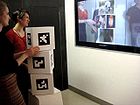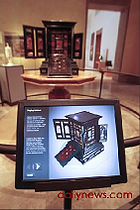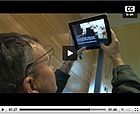Environmental Scan - Current interactive exhibits
From CIRCA
| VTracker |
|---|
| Content deleted. (1 Occurances) |
| Content inserted. (63 Occurances) |
| Content structure inserted. (242 Occurances) |
| Content structure deleted. (5 Occurances) |
| Content changed. (3 Occurances) |
Environmental Scan
Ontario Science Museum
Visitors to the exhibit can also interact with Papagiannis???s Wonder Turner, an AR experience where viewers physically rotate large cubes to reveal and create a new video composition. The cubes are equipped with black and white AR symbols which the software interprets and emits as video clips. Using the classic ???exquisite corpse??? format with four interchangeable heads, torsos and feet, rotating the cubes allows the user to create a wild variety of creatures ??? from a surgeon???s head, belly-dancing torso and penguin feet to a llama head, guitar-playing torso and trampoline feet, and other wondrous creations. An augmented video of the visitor with the transformed turner is simultaneously displayed on the screen.
MOMA NYC
The event illustrates the implications of a technique named "augmented reality": the addition of virtual elements to the real world, viewable using internet-connected and GPS sensitive cameraphones. Augmented reality is chaning our world. In terms of new unlimited visual possibilities, limitless dimensional properties and an unwillingness to comply to (former) physical boundaries and structures, such as a museum wall or context. The 6 floors of the MoMA building were used in a DIY way, and the museum was even extended with a virtual 7th floor.
British Museum
Rooms of the British Museum are augmented. Each of the virtual objects opens a HTTP connection, when tapped and brings visitors to a separate website with additional information.
Getty Museum
The AR feature allows users to experience the Augsburg Cabinet via a 3-D object overlay on a live video feed from the viewer???s webcam???in this case, a simulation of the cabinet. The model spins, tilts, and responds as the viewer interacts with it, creating the sense of participation. This experience is caused both by the viewer's presence in the live video along with hand-eye engagement used to control the cabinet's movement.To simulate the cabinet, our AR feature at www.getty.edu/collectorscabinet consists of a Web page that displays a 3-D, miniaturized model overlaid on a live video feed from the viewer???s webcam. The user feels a sense of engagement by seeing himself or herself in the live video feed, and by controlling the cabinet???s movement???opening, spinning, and tilting it like its original owner could.
Melbourne Museum - Please Touch the Exhibit
Please touch the exhibit lets you explore some of Melbourne Museum???s iconic objects including Phar Lap, Australia???s most famous horse, and the Museum???s massive skeleton of a blue whale ??? as well as some of the less well known, such as fragile birds eggs and tiny, gemlike beetles.Other popular Museum experiences featured in Please touch the exhibit include Bunjilaka Aboriginal Cultural Centre, the Forest Gallery, the Melbourne Story exhibition and some of the new exhibitions in the Science and Life Gallery.
Reuben H. Fleet Science Centre - Balboa Park
"Augmented Reality (AR) Magnet" is currently on display in the Fleet's exhibit gallery. The new AR exhibit, the first of its kind in a Balboa Park museum, serves as a pilot project to investigate the usefulness of mobile apps as teaching tools to enhance hands-on exhibits in informal science educational institutes like the Reuben H. Fleet Science Centre. Using Qualcomm's AR technology, the app has been custom built for the Fleet as part of an interactive exhibit on magnets and magnetism.
Breadboard - Virtual Public Art Project in Philadephia
Breadboard is hooking up with the Virtual Public Art Project (VPAP) to launch a city-wide Augmented Reality (AR) exhibit as part of Philadelphia International Festival of Arts (PIFA). Over 30 virtual art sculptures will be located around the city of Philadelphia and can be viewed via VPAP???s free Layar App for most iPhone and Android smartphone devices. Imagine running up the ???Rocky Steps??? of the Philadelphia Museum of Art and being greeted by an alien creature that could have been designed by Joan Miro ??? but is visible only through your smart phone. The alien will be joined by a giant squid floating above the Schuylkill River waterfall, a faceted rainbow above the Delaware River and 22 other pieces of virtual art throughout the city. The exhibit can be viewed via a free smart phone app that overlays 3-D images on top of real-time screen visuals as seen through the smart phone camera lens.
The site-specific virtual art works included in VPAP@PIFA can be viewed throughout the city by smart phone users. Local and international artists have created unique AR art works, such as the giant squid, that will be geo-tagged to specific locations around Philadelphia and visible via a free Layar App that can be downloaded to iPhone (3GS and above) and Android operating systems. Viewers then have the unique ability to experience an emerging art form as well as new media technology that has a growing influence on our social and commercial interactions.
The Natural History Museum - London UK
Visitors to the Attenborough Studio are usually treated to films and live events depicting the various aspects of nature and biology. A new program has been introduced to the studio, allowing audiences to witness such exhibitions is a way they never have before. Using augmented reality, the museum is blending graphic displays with real life, using film as the preferred medium.One such film features David Attenborough guiding visitors through a tour of the exhibit. Along the way, several computer generated creatures from the world???s distant past make appearances. Other uses of the technology allow visitors to handle virtual specimens, such as baby dinosaurs, or participate in interactive quizzes with other visitors.The use of augmented reality has enabled the museum to present the general public with a way to experience history in a way they could not have anticipated. AR is changing the way people see the world and, in the future, may become an integral part in how we interact with our environment.
National September 11 Memorial and Museum
The official 9/11 Memorial iPhone application for the National September 11 Memorial & Museum is a mobile guide to understanding 9/11 through the eyes of those who witnessed history. The application features a seven stop walking tour of the area around the World Trade Center, accompanied by audio and photo narration. The application also allows visitors to view images related to the events of 9/11 taken nearby wherever you are, and includes an Augmented Reality mode in which photos are overlaid on the camera view. All photos were contributed to the museum by survivors and witnesses through 911history.org.An interactive timeline of the day???s events and aftermath includes dynamic links to witness photos.
Netherlands architecture institute
By means of advanced 3D models, right in the middle of the city UAR shows you on your phone what isn???t there. The city as it once was ??? for instance by showing buildings that once stood there. The city as it might have been ??? by showing scale models and design drawings of alternative designs that were never implemented. And the city of the future ??? by showing artist???s impressions of buildings under construction or in the planning stage.In the application you get all sorts of extra information about architectural projects, architect biographies, sketches, drawings, environments and an overview of the process of the realisation of the projects. UAR brings the ideas and stories in architecture to life by adding audio tours within themes and guides who tell you about the buildings surrounding you.
National Museum of Scotland - Tales of Things
In an experiment to allow visitors to get more involved, staff at Edinburgh's National Museum of Scotland (NMS) have labelled 70 items in one of their exhibitions with QR codes - opening up a range of ways people can interact. Scanning the QR code will activate the app, where each object has its own entry linking to all kinds of content including rare films from the Scottish Screen Archive. It is hoped visitors will help build a social history of each item by adding their own memories and comments. Each object will link to a video containing primary material about the objects. Footage includes:
- The making of a Singer sewing machine
- Optimism during the build of Cumbernauld
- Tenement life
- A Hillman Imp motor car
- Jute production in the 1930s
- A visit to Dounreay Power station
- An interview with Scottish designers Timorous Beasties
Tales of Things is a free QR based system that links an object with its ???tales??? ??? media left by users who have something to say about the object in question. Tales of Things is being used on objects in the Tales of a Changing Nation gallery at the National Museum of Scotland, as well as in the QRator co-creation project at UCL???s Grant Museum of Zoology and The Petrie Museum of Egyptology.
Massachusets Institute of Technology Museum
MIT has put their first QR Code up at the museum as an experiment. This seems like one way to deal with ???nth level??? information that might be interesting to some visitors but not to others. And it???s a way to make it easy for visitors to bookmark information for themselves.They???ve set aside a specific URL space for our codes to send people to. Each link will first take you to a short URL which will then redirect you to the actual URL relevant to the exhibit. The advantage of this is that the museum can also put up short, ???human readable??? links on the exhibits. This will let the museum track how often the links are getting used and what mobile devices people are using.
Powerhouse Museum, Sydney
The Powerhouse Museum in Sydney, Australia has also experimented with QR codes. After finding that too few people had a suitable reader installed on their phones, the museum decided to build a reader into a bespoke mobile application that would serve as an object database and QR code reader in one. This app now supports the museum???s Love Lace exhibition by allowing visitors to access an object???s catalogue entry directly by scanning the QR code on the physical display.
Memory Lane Heritage Village, Nova Scotia
Memory Lane Heritage Village used QR Codes to link to advertisements from the 1930s and 1940s for objects they had on display.
Cleveland Art Museum QR Code Shawabtys and Cista Handles for Gallery Tour
???How Do you See It???? An outline form of the Egyptian Shawabtys and Etruscan Cista Handle decorate current Cleveland Art Museum promotions with QR code and take visitors on a tour with their phones.Since the campaign began early summer, Cleveland Art Museum has had roughly 400 scans, according to Christa Skiles, assistant director of communications, linking smartphone users to an online version of the audio tour. ???The tour is for the new galleries that opened at the museum this summer: ancient Near East, Greek, Roman, Egyptian art; Byzantine and medieval art; African art; and prints and drawings.???
Louisiana State Museum - Living with Hurricanes: Katrina and Beyond
The exhibit, located in the heart of the French Quarter, will have damaged artifacts that were managed to be salvaged after the storm, in addition to videos that tell the tale of survival and rescue.By using QR codes throughout the items on exhibit, visitors will be able to use their smartphones in order to link to more in-depth information. In addition, the QR codes will link to the exhibit???s Facebook page, where visitors can upload their own experiences and or thoughts. In turn, this will allow the exhibit to become a more interactive place, where visitors can get real-life stories of those who survived.This exhibit has not yet opened. It is expected to open at the end of October.










